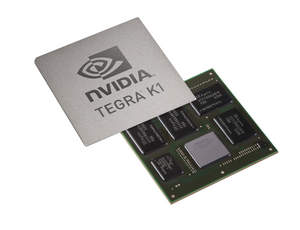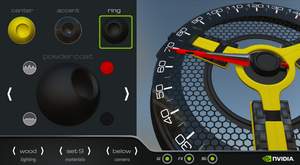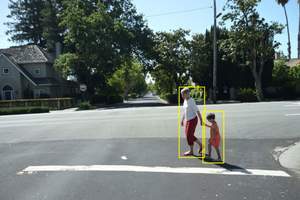LAS VEGAS, NV--(Marketwired - Jan 6, 2014) - CES -- NVIDIA's new Tegra® K1 mobile processor will help self-driving cars advance from the realm of research into the mass market with its automotive-grade version of the same GPU that powers the world's 10 most energy-efficient supercomputers.
The first mobile processor to bring advanced computational capabilities to the car, the NVIDIA® Tegra K1 runs a variety of auto applications that had previously not been possible with such low power consumption.
Tegra K1 features a quad-core CPU and a 192-core GPU using the NVIDIA Kepler™ architecture, the basis for NVIDIA's range of powerful GPUs -- including the processors that are used in the top 10 systems featured in the latest Green500 list of the world's most energy-efficient supercomputers.
Tegra K1 will drive camera-based, advanced driver assistance systems (ADAS) -- such as pedestrian detection, blind-spot monitoring, lane-departure warning and street sign recognition -- and can also monitor driver alertness via a dashboard-mounted camera.
"To process the steady deluge of sensor and camera data required by a self-driving car, NVIDIA is bringing highly energy-efficient supercomputer technology inside the vehicle," said Taner Ozcelik, vice president and general manager of the Automotive business at NVIDIA. "Tegra K1 solves this by providing 10 times the computing power of previous mobile processors without consuming additional energy."
The Tegra K1 is also the first mobile processor to support CUDA® -- the parallel computing platform at the heart of modern computer vision. In its automotive-grade form, this super chip is hardened to withstand a wider range of temperatures and withstand harsher operating conditions.
Customizable Digital Dashboards
In addition to computer vision, the Tegra K1 processor excels at creating razor-sharp, photo-real 3D graphics. Using NVIDIA's Material Definition Language -- which simulates how light reflects and refracts off of actual materials -- digital instrument clusters and infotainment systems can be customized with a wide range of virtual materials, from copper, titanium and brushed aluminum, to stitched leather and carbon fiber.
Libraries of photo-realistic rendered material provide a nearly limitless range of customizable digital cockpit configurations. These allow drivers to configure their gauges, controls and dials to suit their unique tastes.
"Audi and NVIDIA have a long, deep partnership, in which we've utilized three generations of Tegra to bring industry-leading capabilities to the instrument cluster, infotainment and rear seat entertainment systems," said Ricky Hudi, chief executive engineer of electrics/electronics at Audi AG. "Tegra K1 opens a new chapter for Audi to deliver revolutionary supercomputing advances to the car, paving the way to piloted driving experiences."
Programmability Extends Life of Vehicle
ADAS solutions currently in the market are based mainly on proprietary processors. NVIDIA Tegra K1 moves beyond this limitation by providing an open, scalable platform that enables innovative solutions.
In addition, NVIDIA designed the Tegra K1 processor to be fully programmable, so it can be enhanced via over-the-air software updates that support new functionalities as they become available from automakers.
"Advanced computational technologies are the foundation for turning automobiles into the most innovative, capable and desirable mobile devices in the future," said Thilo Koslowski, vice president and lead automotive analyst at Gartner. "By offering over-the-air upgradeability of these technologies, automakers can improve existing in-vehicle features and offer new ones over the course of the vehicle lifecycle."
Module Supports Range of Operating Systems
Tegra K1 will be available to automotive OEMs and Tier 1 suppliers as a visual computing module (VCM), an innovative design first introduced two years ago. The Tegra K1 VCM delivers a full computer system for the vehicle, capable of running various operating systems including QNX, Android, Linux or Windows.
The Tegra VCM allows in-vehicle systems to be easily upgraded as newer hardware becomes available, closing the gap between the rapid pace of innovation in the consumer electronics space and the longer development lifecycles typically experienced in the automotive industry.
"NVIDIA's modular approach enables automakers to fast track development with breakthrough technologies like the Tegra K1, without having to start from scratch," said Roger Lanctot, associate director within the Global Automotive Practice at Strategy Analytics.
NVIDIA Automotive Technology Driving Innovation
Today there are more than 4.5 million cars on the road powered by NVIDIA processors, including the newest models from Audi, BMW, Tesla Motors and Volkswagen. Find out more at www.nvidia.com/automotive.
The power of the NVIDIA Tegra K1 processor for automotive applications will be demonstrated in NVIDIA booth 30207 at the 2014 International Consumer Electronics Show in Las Vegas, Jan. 7-10, in the South Hall of the Las Vegas Convention Center.
Keywords
NVIDIA, Tegra K1, mobile, CUDA, GPU, CPU, automotive, infotainment, navigation, ADAS, CES
To Keep Current on NVIDIA:
- Like NVIDIA on Facebook.
- Connect with NVIDIA on LinkedIn.
- Follow @NVIDIA on Twitter.
- View NVIDIA videos on YouTube.
- Keep up with the NVIDIA Blog.
- Use the Pulse news reader to subscribe to the NVIDIA Daily News feed.
About NVIDIA
Since 1993, NVIDIA (
Certain statements in this press release including, but not limited to, statements as to: the features, impact and benefits of the Tegra K1 processor are forward-looking statements that are subject to risks and uncertainties that could cause results to be materially different than expectations. Important factors that could cause actual results to differ materially include: global economic conditions; our reliance on third parties to manufacture, assemble, package and test our products; the impact of technological development and competition; development of new products and technologies or enhancements to our existing product and technologies; market acceptance of our products or our partners' products; design, manufacturing or software defects; changes in consumer preferences or demands; changes in industry standards and interfaces; unexpected loss of performance of our products or technologies when integrated into systems; as well as other factors detailed from time to time in the reports NVIDIA files with the Securities and Exchange Commission, or SEC, including its Form 10-Q for the fiscal period ended October 27, 2013. Copies of reports filed with the SEC are posted on the company's website and are available from NVIDIA without charge. These forward-looking statements are not guarantees of future performance and speak only as of the date hereof, and, except as required by law, NVIDIA disclaims any obligation to update these forward-looking statements to reflect future events or circumstances.
© 2014 NVIDIA Corporation. All rights reserved. NVIDIA, the NVIDIA logo, Tegra, Kepler, Tesla and CUDA are trademarks and/or registered trademarks of NVIDIA Corporation in the U.S. and other countries. Other company and product names may be trademarks of the respective companies with which they are associated. Features, pricing, availability and specifications are subject to change without notice.
Contact Information:
For further information, contact:
Denise Iwata
NVIDIA Corporation
(408) 775-5357
diwata@nvidia.com


